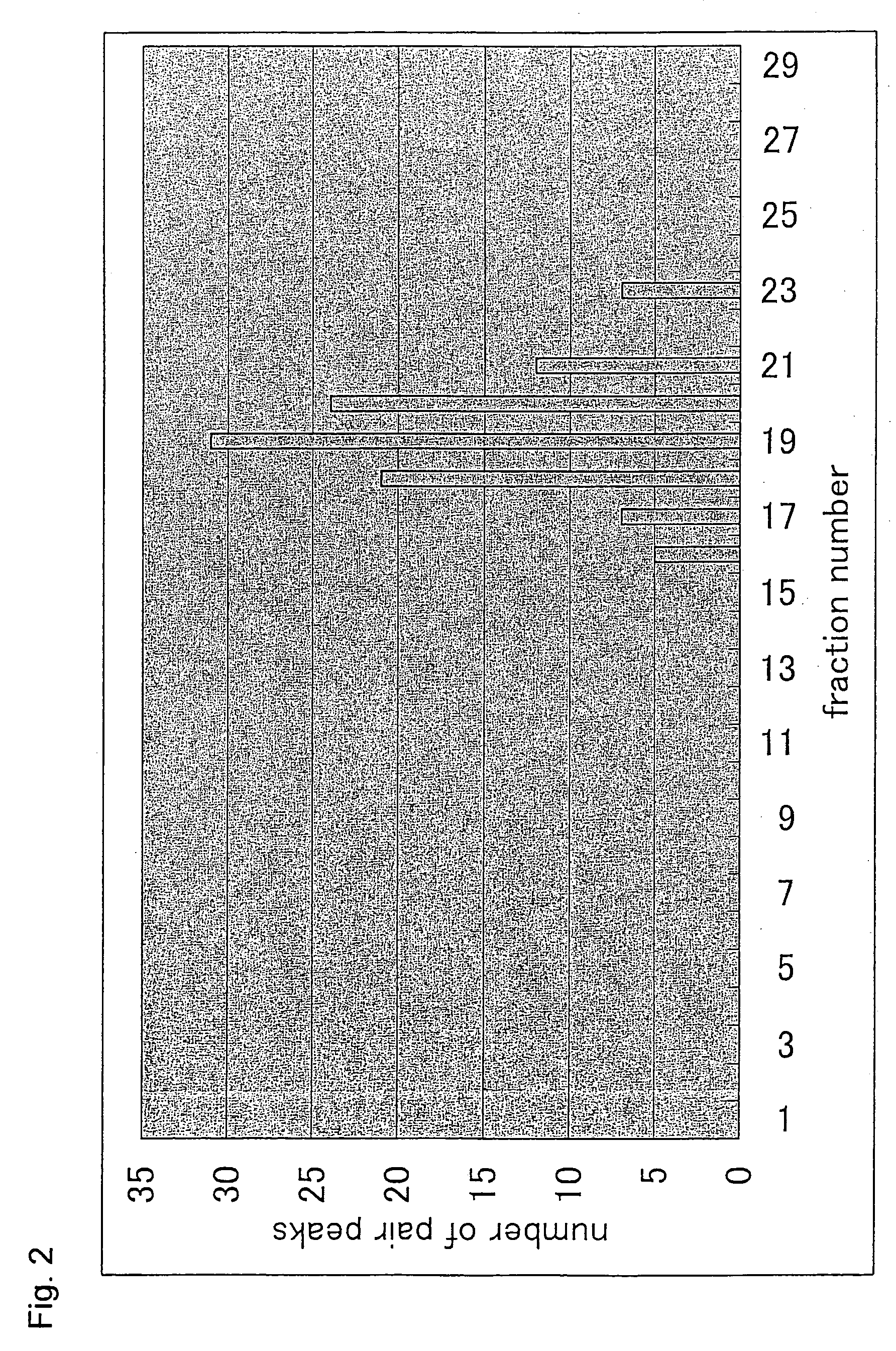Sulfenyl compound, labeling reagent, and method of analyzing peptide
a peptide and compound technology, applied in the field of exhaustive analysis of proteins, can solve the problems of inability to accurately detect differential displays, and inability to accurately quantify proteins, etc., to achieve the effect of increasing the purity of labeled peptide molecules
- Summary
- Abstract
- Description
- Claims
- Application Information
AI Technical Summary
Benefits of technology
Problems solved by technology
Method used
Image
Examples
example 1
Synthesis of Sulfenyl Compound
[0125] In this example, 2-nitro[13C6] benzenesulfenyl chloride (heavy reagent) was synthesized from a corresponding sulfide.
(Synthesis of Sulfide)
[0126] 1 g (6.1×10−3 mol) of 2-nitrochloro[13C6] benzene was dissolved in 1 ml methanol. To this, 0.8 g (6.6×10−3 mol) benzyl mercaptan and 0.8 ml (0.01 mol) pyridine were added and refluxing was performed for 16 hours while heated. By cooling to room temperature, 2-nitro[13C6]phenyl benzyl sulfide was crystallized. The formed crystal was collected by filtration and was washed with methanol, and drying with air. This gave 1.38 g (90%) of 2-nitro[13C6]phenyl benzyl sulfide as a yellow crystal.
(Synthesis of Heavy Reagent)
[0127] To 1.38 g (5.5×10−3 mol) of 2-nitro[13C6]phenyl benzyl sulfide obtained above, 10 ml ethylene chloride and then 940 mg (7.9×10−3 mol) sulfuryl chloride were added, and stirring was performed at room temperature. The reaction mixture was concentrated under reduced pressure while mai...
example 2
Separation Experiment
[0130] Using ACTH, Galanin, and PTH as model peptides and 2-nitro[12C6] benzenesulfenyl chloride (light reagent) as the labeling reagent, an experiment was conducted to see if the labeled peptides can be separated from their unlabeled peptides.
[0131] 160 μg (5.4×10−8 mol) ACTH was added to 100 μl of a 70% aqueous solution of acetic acid. To this, 0.41 mg (40 mol) of 2-nitro[12C6] benzenesulfenyl chloride was added and stirring was performed by vortex mixer at room temperature for 1 hour. The reaction mixture was chilled in an ice bath, followed by addition of 800 μl ice-chilled ether and centrifugation. The resulting precipitate was washed with ice-chilled ether to obtain the labeled form. The labeled peptide was mixed with the peptide not subjected to labeling and separation was performed on a reversed-phase column (LC). The same procedures were followed for Galanin and PTH, and the respective retention time was showed as follows. The results are as shown bel...
example 3
Separation Experiment
(Labeling)
[0139] Using lysozyme as a model protein, an experiment was conducted for the same purpose as in Example 2. In this experiment, the labeling, chemical treatment, and enzymatic digestion were performed in this order.
[0140] Lysozyme was labeled with the “light reagent” in the same manner as in Experiment 2, and then washed and freeze-dried. Subsequently, the chemical treatment (reduction of disulfide linkages and S-carbamidomethylation) and the enzymatic digestion, as described below, was performed.
(Reduction of Disulfide Bonds)
[0141] 100 mM NH4HCO3 was added to this for dissolving, 50 molar equivalents of DTT with respect to one disulfide bond were added, and the reaction was allowed to proceed at 56° C. for 1 hour.
(S-carbamidomethylation)
[0142] After the reaction mixture was allowed to cool to room temperature, 100 mM NH4HCO3 solution of iodoacetamide was added and the reaction was allowed to proceed at room temperature for 1 hour. The reacti...
PUM
| Property | Measurement | Unit |
|---|---|---|
| Force | aaaaa | aaaaa |
| Fraction | aaaaa | aaaaa |
| Length | aaaaa | aaaaa |
Abstract
Description
Claims
Application Information
 Login to View More
Login to View More - R&D
- Intellectual Property
- Life Sciences
- Materials
- Tech Scout
- Unparalleled Data Quality
- Higher Quality Content
- 60% Fewer Hallucinations
Browse by: Latest US Patents, China's latest patents, Technical Efficacy Thesaurus, Application Domain, Technology Topic, Popular Technical Reports.
© 2025 PatSnap. All rights reserved.Legal|Privacy policy|Modern Slavery Act Transparency Statement|Sitemap|About US| Contact US: help@patsnap.com



